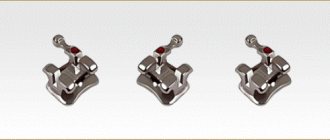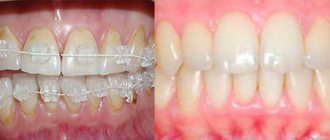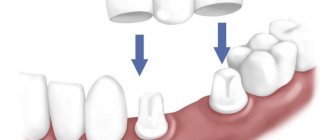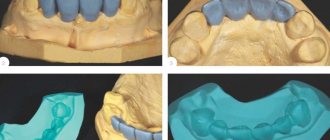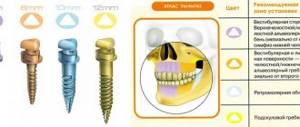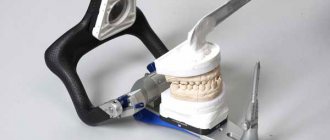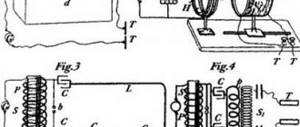Author: Sergey Evgenievich Brodsky Deputy Chief Physician, Candidate of Medical Sciences in the specialties: dentistry and medical microbiology A fragment of an instrument in the tooth canal remaining after treatment is an extremely unpleasant complication that occurs in the practice of any dentist, even one with high qualifications and many years of experience. In itself, such a complication of endodontic treatment does not cause harm, since the alloy used to make files (special needles for passing through tooth canals) is quite inert and does not cause allergies. However, the problem associated with the breakage of an instrument in a tooth canal is that metal debris clogs the tooth canal , and the doctor cannot clean it properly.
Deputy chief physician
Brodsky Sergey Evgenievich
Sign up for a free consultation
+7
Types of pins and features of their removal
A pin is a kind of rod that is implanted into the tooth root to strengthen it. The pins are made of durable materials, which ensures that the teeth are maintained in their normal position and can withstand chewing loads. The pin is used if the crown is destroyed and it is necessary to preserve it or install an artificial prosthesis on it.
The pin is often used as a support under a prosthesis. Sometimes situations arise when the implant needs to be removed.
Tooth posts can be made of metal or fiberglass. The latter are used when dental prosthetics are performed and a tiled crown is installed. The fiberglass dental core is fairly easy to remove if necessary. However, dentistry more often uses metal dental pins, which have gained popularity due to their high strength. Metal rods are also called anchor rods.
Types of tooth root crack
Pressure can be applied both vertically and perpendicularly to the crown. The following types of cracks are distinguished:
- oblique crack of a tooth
- a diagonal fracture, usually the healthy part is much larger, and the doctor can save the tooth by removing the affected part; - transverse crack of a tooth
- part of the root is completely broken off and deprived of nutrition; the closer the crack is to the coronal part, the higher the risk of complications; - longitudinal crack in the root of a tooth
- the fracture runs vertically, along the axis of the root, often accompanied by a fracture of the crown; - comminuted tooth crack
- multiple root fractures intersecting with each other.
Features of removing metal teeth pins
The anchor pin can be titanium, palladium or stainless steel. In addition, dental rods are made from brass and precious metals. The installation of such rods is used if the crown of the teeth is severely damaged.
During implantation, the pin is strengthened in the dental canal with phosphate cement. Such fixing material can be destroyed using ultrasound. This treatment is necessary if repeated caries appears around the rod. To remove the metal pin, the tooth is freed from the filling material, the rod is treated with ultrasound and removed from the tooth cavity.
There are also situations when, due to the excessive strength of the fixing cement, the tooth pin begins to shift under the influence of chewing loads. This may damage the prosthesis and the structure will have to be removed. In most cases, displacement of the dental core is detected at an advanced stage of tooth damage. Then the pin has to be removed along with the dental unit. However, sometimes it is possible to perform treatment and save the tooth. To do this, part of the tooth tissue is removed around the rod-shaped implant, after which the pin is unscrewed. After this method of extracting the dental core, the dentist performs repeated treatment, treats the canals and places a temporary or permanent filling.
Causes of crown loosening
Have you noticed that the tooth on the pin is loose? The reasons may be:
- incorrect selection of metal rod,
- violation of preparation rules,
- disregard for contraindications to the procedure,
- use of low-quality dental cement,
- allergic reaction and inflammation,
- lack of proper care,
- eating tough and hard foods during the first 3-4 weeks after restoration.
A tooth on a pin can also become loose due to jaw injury and root destruction.
Features of extraction of parapulpal dental pins
Parapulpal rods are classified as non-metallic. They can be made of gold or special stainless steel. Such pins have a polymer coating and can be used for reinforcement and retention of dental fillings. The main distinguishing feature of parapulp pins is their installation and implantation into the hard tissue of the tooth without affecting the nerve. This provides the advantage of eliminating the risk of pulp infection or the development of inflammatory processes in the oral cavity. The reason for removal and the main disadvantage of such pins is that they are located nearby, their close location to the surface of the teeth, and therefore the rods often break dental units, after which treatment and their reinstallation are necessary.
Parapulpal pins are much easier to remove than anchor pins. This is due to the fact that non-metallic rods do not require deep intervention. Usually it is enough to grab the end and remove the pin, after loosening it. It is not necessary to use ultrasonic devices. Removing titanium pins presents certain difficulties and carries the risk of root damage.
Dental pins are removed using dental instruments; dentistry divides them into standard and special. Standard ones are suitable for removing rods with minor damage and are cylindrical or cone-shaped.
Special surgical instruments can have a wide variety of shapes (hook-shaped, blade-shaped, etc.) for use in unusual situations when the pin is severely damaged or deflected.
What Causes Injury?
The main reason why tooth crown damage occurs is weakened enamel.
In such cases, microcracks and chips often form, which subsequently lead to a crown fracture. But even strong teeth can be injured under strong mechanical stress, however, this usually happens simultaneously. The reason for the weakening of the enamel can be:
- poor quality dental treatment;
- deficiency of calcium, phosphorus and fluorine;
- violation of nutrition rules;
- constant exposure to food acids;
- disruption of the pancreas with uneven release of acidity;
- the effect of different temperatures when eating food (hot-cold);
- jaw injuries.
With weakened teeth, a crack can also occur as a result of the habit of chewing hard objects or foods, nails, packaging, etc.
Dentists warn that those at greatest risk are patients who have had prior dental treatment with pulp removal or a filling placed on a large, diseased crown cavity.
Diagnosis and indications for tooth pin extraction
- Some time after the implants were installed, repeated caries appeared under the crown around the pin.
- The patient feels pain under the crown of the tooth that was treated and into which the rod was implanted.
- A tooth with a pin is severely destroyed or deeply damaged by caries.
- The teeth pins have reached the end of their useful life and the post needs to be replaced.
- After removing the pin, fragments remained in the dental canal. This situation can arise in the case of a fiberglass rod due to its transparency. The debris may be discovered when an X-ray is taken.
- Implants are rejected by the body.
Consequences of the problem
Modern endodontist instruments often break, and no specialist can prevent the instrument from breaking in the tooth canal in advance. Neither a thorough visual inspection of the tools nor restrictions on their use will help with this - even a new tool can suddenly break. If the instrument file breaks off in the tooth canal, this may have a negative impact on subsequent dental procedures.
In most cases, an instrument remaining in the tooth canal, its distant part, brings the following consequences:
- Pieces of the file remaining after the instrument is broken in the tooth canal may undergo corrosion processes, resulting in irritation of the walls of the root canal, which can lead to tooth loss.
- If an instrument is left in the tooth canal, it can provoke inflammatory phenomena, especially if particles of infected pulp remain on the broken fragment or underneath it.
- Leaving an instrument in the tooth canal does not allow filling the remaining part of it.
Causes of tooth pin rejection
- The treatment was carried out due to a medical error. During the installation of the dental rod, the dentist could touch a nerve or maxillary sinus. In such situations, the process of healing and tissue fusion may go wrong.
- The use of low quality equipment used for implantation.
- The patient’s immunity is reduced or he or she has possible diseases that have a depressing effect on the functioning of the immune system.
- Injuries to teeth with a pin.
- Improper oral hygiene, patient abuse of bad habits.
- Possibility of defects in the dental core. This cause of implant failure is quite rare.
When pin rejection begins, it is necessary to seek help from a dentist as soon as possible in order to begin treatment as early as possible. To prevent complications, it is important to know the first signs of tooth rejection.
Causes of a crack in the root of a tooth
Not all patients understand why a root crack occurs in a living tooth. The reason lies in the uneven distribution of the load. Moreover, the load can be strong and sudden, or it can accumulate over years and lead to the appearance of a crack after some time.
Typically, the cause of a crack is caused by the following factors:
- domestic trauma
- blow, fall, sudden load while chewing; - improper treatment
- strong pressure when cleaning canals or filling the root can injure the walls and in the future, with the slightest excessive load, cause a crack in the root; - error during prosthetics
- strong pressure when installing a pin or the manufacture of inappropriate dentures that unevenly distribute the load during chewing, leading to injury; - Bruxism
- unconscious clenching of the jaws, for example, during sleep, leads to a load that the patient does not notice and cannot control.
Symptoms of pin rejection
- Formation of local inflammation in the area of the tooth with an implant. It can manifest itself in the form of redness and swelling of the gums, pain and a feeling of “fullness”.
- Headache and increased body temperature.
It is very important to seek professional help at the first signs of pin rejection; treatment is necessary. This is due to the fact that the inflammatory process can spread to bone tissue, and then antibacterial and anti-inflammatory drugs will no longer be able to help.
Methods of treatment and restoration
If a tooth is cracked, whether it can be saved will depend directly on the nature of the injury and the time after which the person went to the dentist. With a high probability, you can save a tooth with small chips and microcracks. The use of composite materials will allow you to restore the crown without visible aesthetic defects.
The situation is much more complicated with extensive cracks. Crown restoration and treatment are carried out only if at least a third of the tooth root is preserved and there are no inflammatory or infectious processes.
In case of significant vertical or diagonal cracks, dentists remove one part of the crown and build up the second half or install a prosthesis on implants. Such manipulations are necessary, because even if the crack has not reached the base of the tooth, under load it will still crack the tooth and its integrity will require re-treatment after some time. Damage to the root system, jaw tissue, and pulp is performed by tooth extraction. Extraction is also used for damaged wisdom teeth.
If a tooth is cracked in half, it can be saved, but only partially if there is no serious damage. You should not delay your visit to the doctor. Modern dentistry has enormous possibilities for restoring teeth; even if removal is required, the crown can be restored with the help of prostheses that will not differ from the rest of the teeth.
Stages of tooth pin removal
- The latex tab is placed on the teeth before the procedure begins. The inlay is necessary to isolate the tooth being treated from the rest of the oral surface.
- The dental core is then carefully treated with ultrasound, during which it is loosened and carefully removed from the dental canal.
Next, doctors move on to sanitation of the tooth. The dentist removes the old filling material from it, freeing the passage for the pin.
After removal of the implant, the patient receives information and recommendations on further oral care and daily hygiene rules. The specialist will also give advice on monitoring the condition of the wound surface and how recovery is progressing. In order for the rehabilitation period to be successful, you must visit your doctor for follow-up examinations and temporarily give up bad habits (smoking, drinking alcohol). The dental post re-installation service can be performed several months after the removal of the previous implant. It is necessary for the dental tissue to be completely restored.
You can remove a tooth pin in the city of St. Petersburg at the World of Dentistry clinic. Our Center provides dental services at the highest professional level; the clinic’s policy is affordable prices for treatment. You can find out the cost of removing one dental implant and the prices for treatment and all services in general by consulting a specialist. We have professional computer diagnostics; consultations are conducted by highly qualified orthodontists. Our dentistry provides high-quality orthodontic services; to correct the bite, ceramic, metal or combined braces can be installed, teeth whitening, fissure sealing, professional oral and gum hygiene. There is pediatric dentistry and excellent reviews from grateful patients. You can have a ceramic crown, a zirconium dioxide crown, a fixed or removable nylon prosthesis for one jaw, or metal ceramics installed - in any case, the production will be quick, the treatment and operation under anesthesia will be painless, and the visit will be pleasant. There are promotions and discounts, a discount card for customers. If a tooth pin has to be removed due to its poor quality, the patient can count on a free implant replacement. Come to the World of Dentistry clinic. A world of beautiful smiles on Kondratievsky Prospekt in St. Petersburg, appointments are conducted by experienced dentists, orthopedists and therapists.
Price for removing a broken instrument from a dental canal in Partner-Med
| Dental service | Price* for cash in rubles |
| Extraction of 1 foreign body, or 1 pin, or 1 broken instrument from the root using a microscope (Promotion) | 5 500 ₽ |
| Extraction of 1 foreign body, or 1 pin, or 1 broken instrument from the root using a microscope | 8 690 ₽ |
*The indicated cost of the service is valid for DECEMBER 2020 for patients visiting our clinic for the first time. Please check the current cost with individual prices available for you by calling + 7
Just pick up the phone and call us!
8
We will definitely make you an offer that you cannot refuse!

